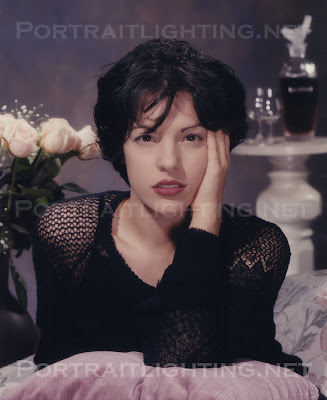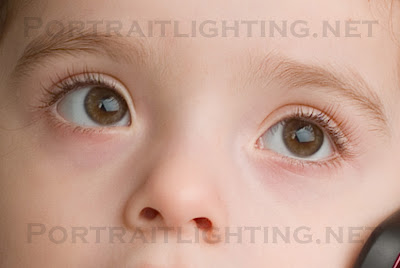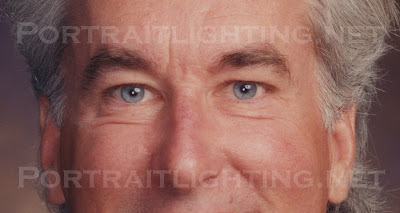
The above image, scanned from an old print, provides a good example of how smaller light sources are rendered as reflections in the eye. Click on the image to enlarge and examine the eyes. You will see two small white dots in both eyes, each one a specular reflection of a light source. The faint one at 11 o'clock was created by a 7 inch grid-covered strobe, and the one just below the center of the eye by a 16 inch reflector fitted with a diffusion cap. The grid spot was placed above and slightly to the subject's right and pointed downward. That is why its reflection is very high in the eye. The long shadow under the nose is another indicator of the grid spot's high position. The 16 inch strobe, which provided a generous overall fill lighting for the scene, was positioned back just below the camera. In this position, its catchlight is quite small and, as expected, appears just below the eye center. Had it been positioned closer, as for instance as a main light, its reflection would have appeared larger. You can expect other small light sources and larger sources placed far from the subject to create similar catchlights. Keep in mind that this image was lighted with additional sources placed behind the subject, but only the two in front the subject rendered as catchlights.

The image above shows the catchlights resulting from a large softbox placed close to the subject. The softbox catchlight rendered as a skewed trapezoid with a translucent quality. If you look closely, you can also see a reflection to the left of softbox catchlight from fill light bounced off the wall behind the camera. Large sources create large catchlights, and the closer the source, the larger the catchlight. The tranlucent quality of these larger reflections results from the distribution of light energy over a large diffuser surface. Reflections from a smaller sources with equivalent output will be commensurately brighter, as the same amount of energy must come from a smaller surface area. The skewed shape of the rectangular-softbox catchlight occurred because the softbox was not square to the subject, but extended from the just right of the subject's left ear back to the camera and was tilted downward slightly. Skewed rectilinear boundaries can tell you a lot about a source's position and inclination.

The final image in today's post is a small section scanned from an old executive portrait. You can use catchlights to gain insights into the lighting, but you can also be misled by them. This example demonstrates some of the limitations. Two catchlights per eye are clearly visible in this example. The one at one o'clock is from a 46" umbrella with a diffusion cover and the one near the eye center from a 60" umbrella behind the camera. Two things are clearly demonstrated here: it's hard to determine source size from catchlight size, and it's hard to determine source strength from catchlight intensity. In this image, the catchlight for the 46" umbrella is larger than that of the 60" one, because the 60" umbrella was in an unusually distant position. Also, the 46" umbrella catchlight appears less bright than that of the 60" umbrella, yet the 46" umbrella was delivering about 1.5 f-stops more light to the subject. I think you get the point.
It should be noted that catchlights may be eliminated, modified, or added for artistic reasons. It is still a fairly common practice to retouch out a fill-light catchlight in portraits, so keep that in mind.
In the next post we'll dig a bit deeper into reverse engineering.